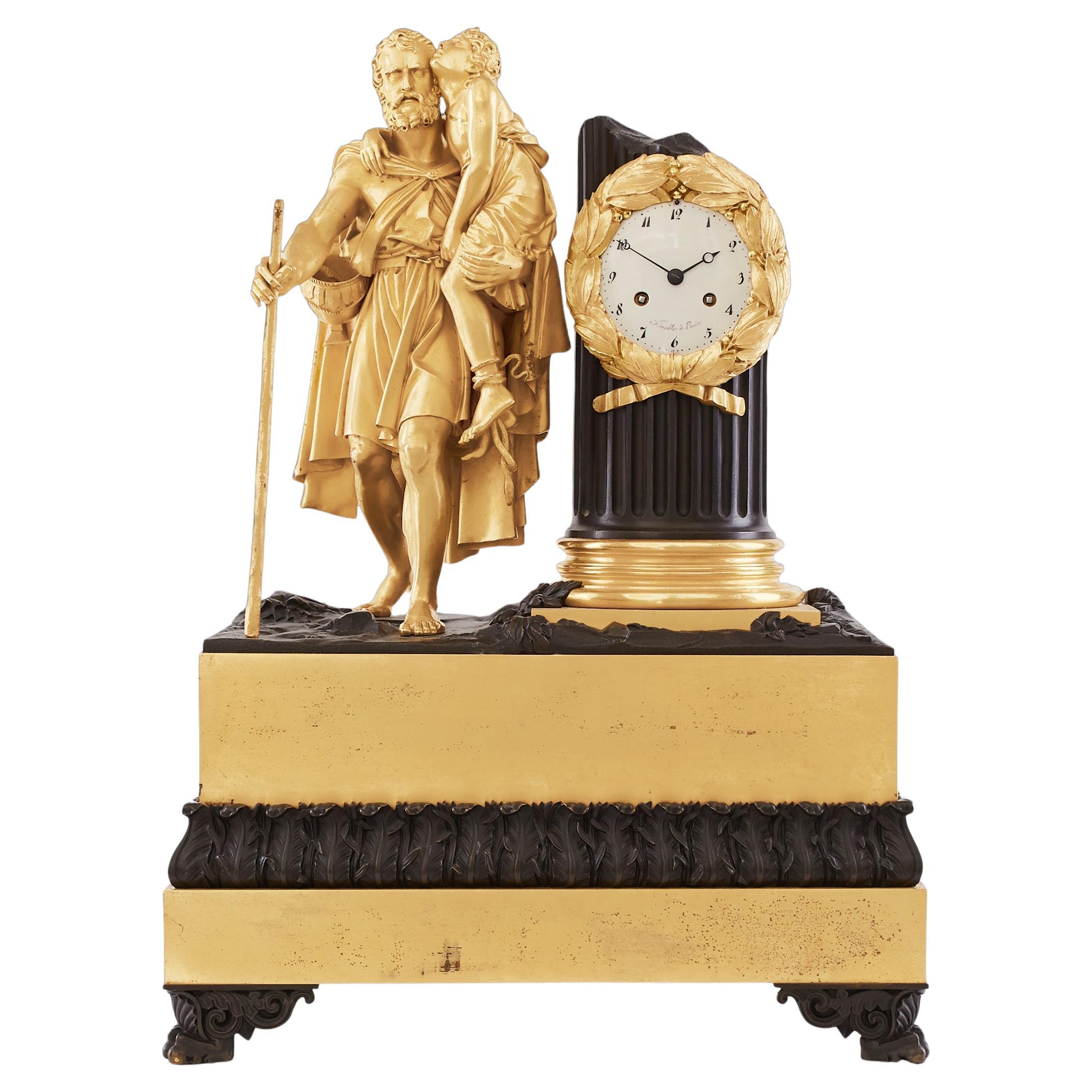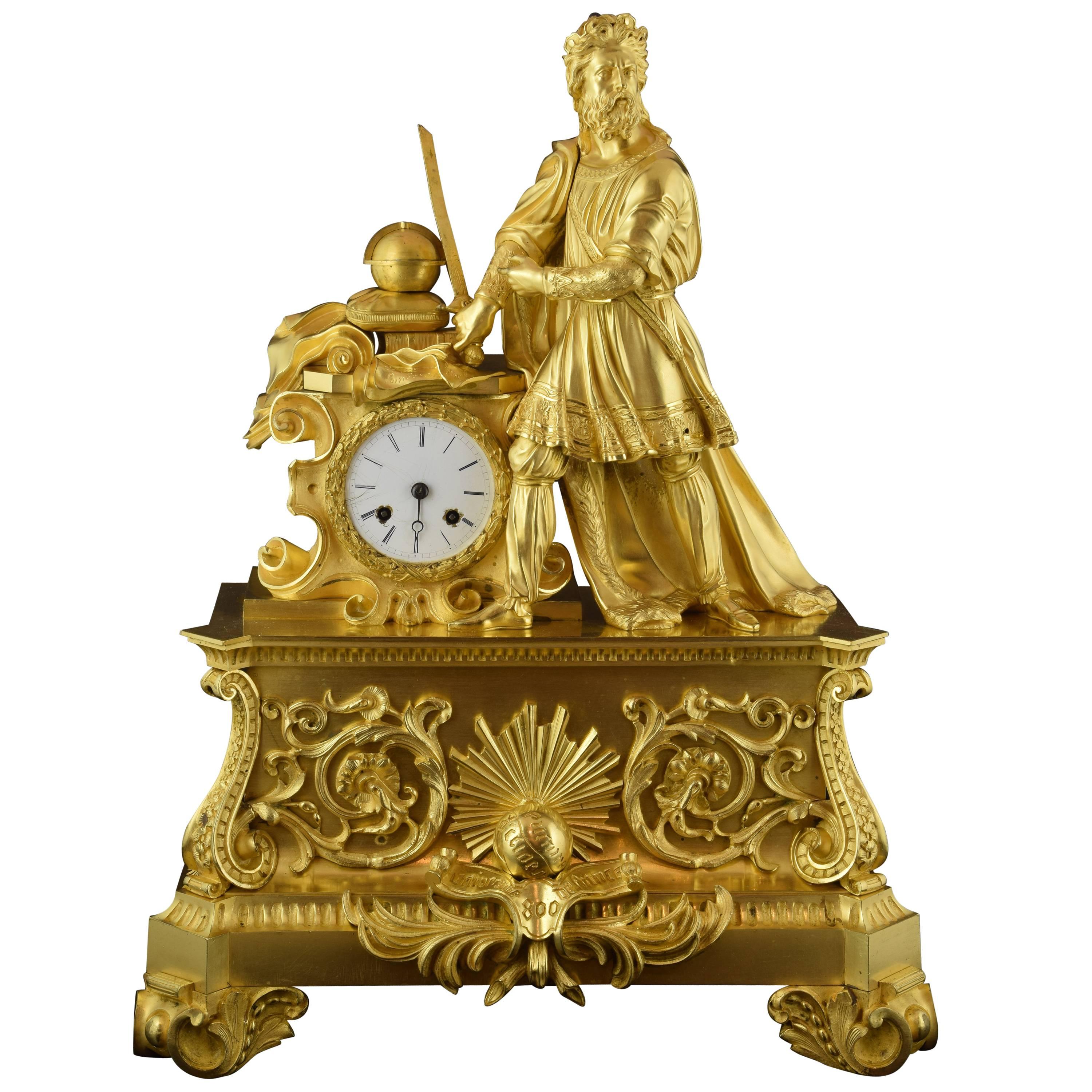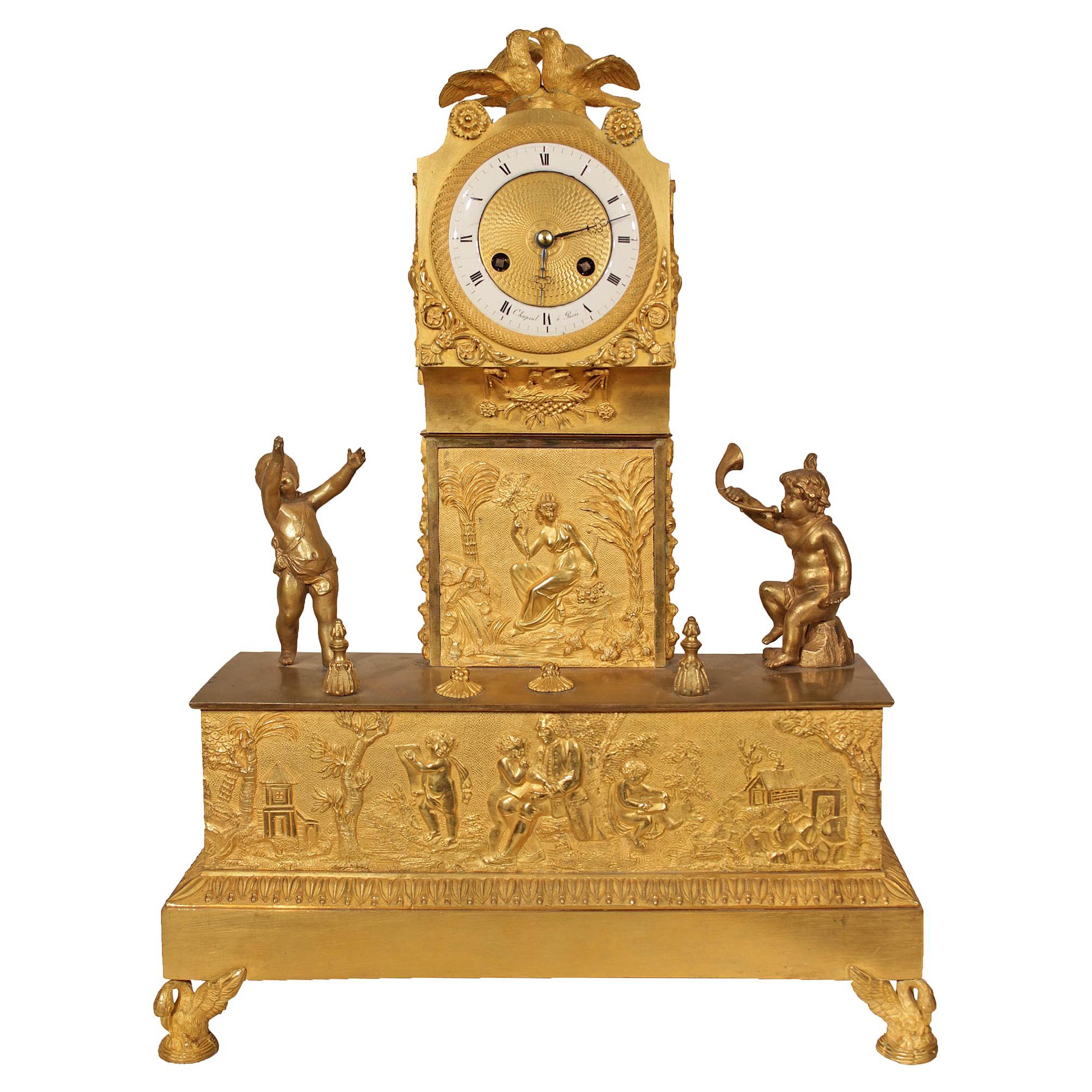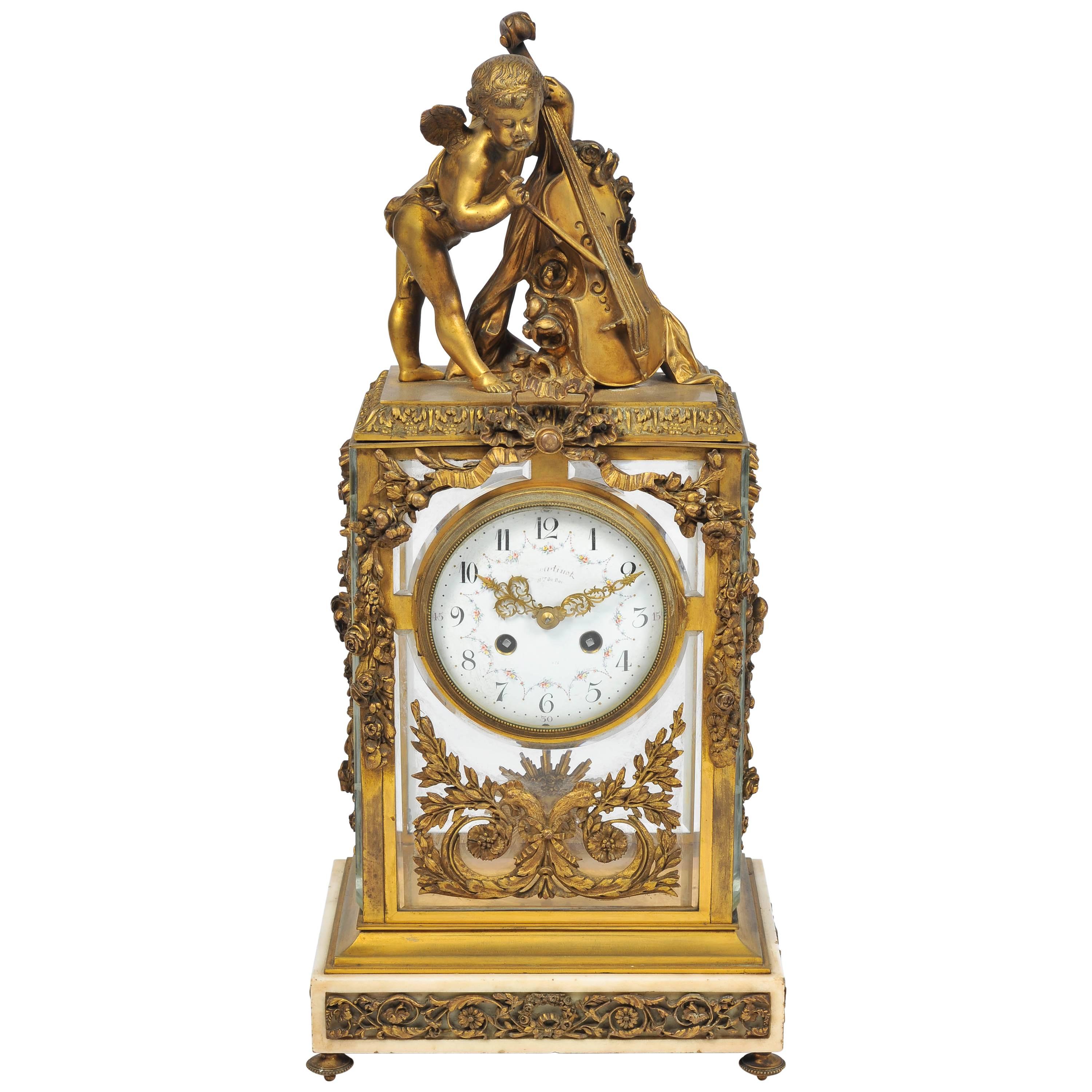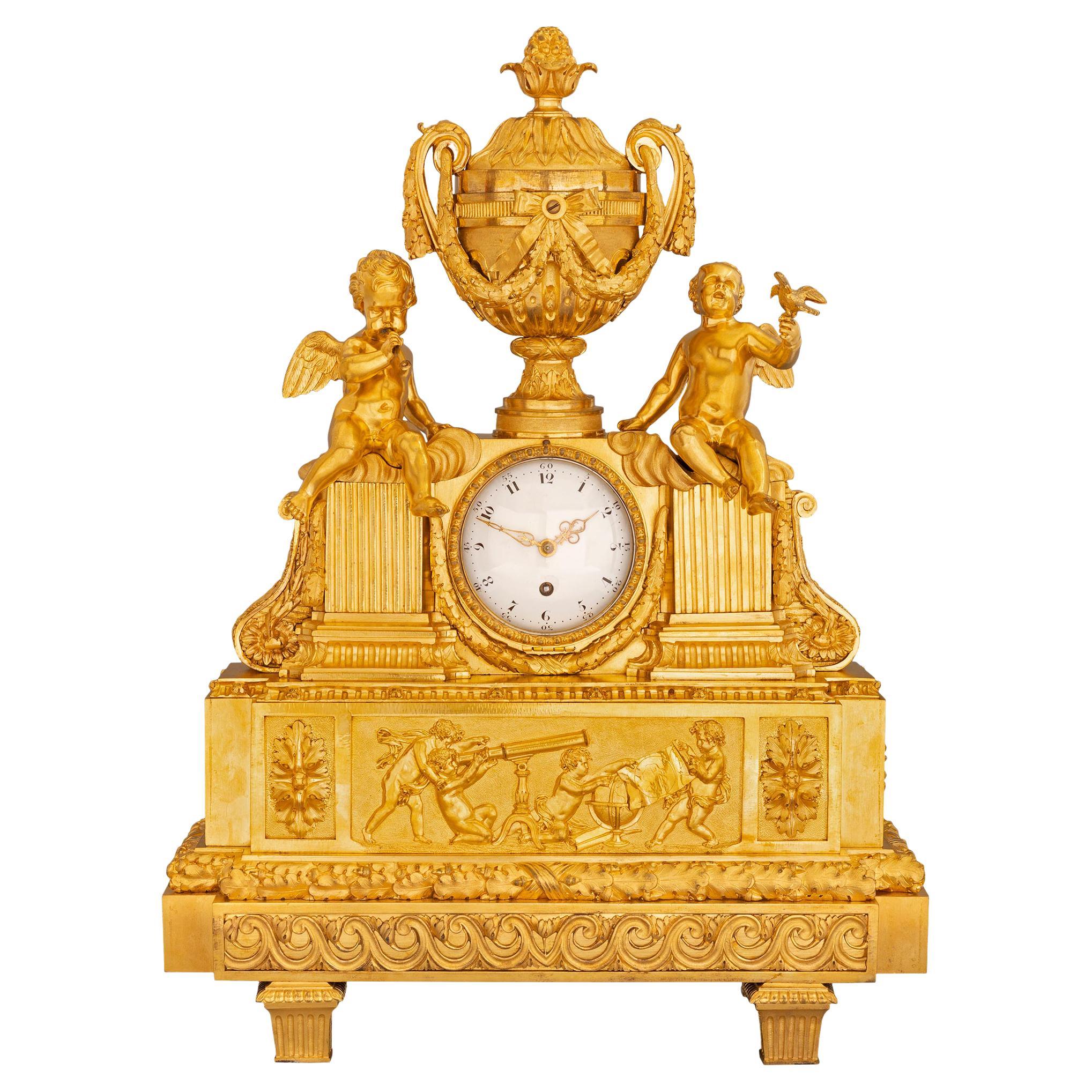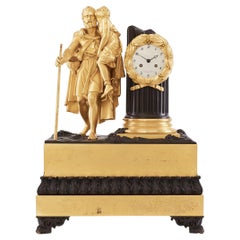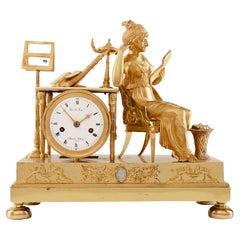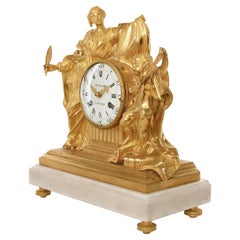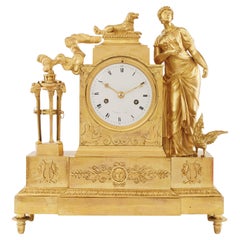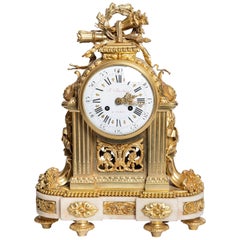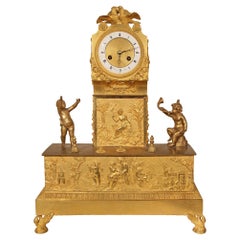Items Similar to Mantel Clock 19th Century Styl Empire by Ferdinand Berthoud À Paris
Want more images or videos?
Request additional images or videos from the seller
1 of 7
Mantel Clock 19th Century Styl Empire by Ferdinand Berthoud À Paris
$4,157.97
£3,119.24
€3,500
CA$5,757.01
A$6,256.88
CHF 3,353.12
MX$75,969.64
NOK 42,096.34
SEK 39,037.96
DKK 26,663.50
About the Item
Ormolu bronze mantel clock flanked by a troubadour and musical instruments, signed 'Ferdinand Berthoud a Paris'.
The end of the 18th and beginning of the 19th century was a crucial time in which new technological advances helped to make watches more accurate and more portable. During the 1790s, the production of gilded bronze increased considerably as working conditions improved. The freedom of trade initiated by the French Revolution allowed many casters to develop large factories. The new factory environment gave them a chance to execute all stages of bronze work including drawing, casting, gilding, assembly, and trade of art objects. While the bronzers took creative liberty in creating all kinds of clocks in contrast to the noble and rigorous structure carried by the movement of neoclassicism. Under the reign of Empire, the case designs started gradually to develop away from a proportionate and strict classicism towards a baroque style and revival style. The rediscovery of medieval civilization was one of the intellectual curiosities of the beginning of the 19th century, with much input from the Ancien Régime and its institutions, rites and the medieval churches in which family ceremonies occurred.
This early nineteenth-century figural mantel clock is surmounted by a medieval musician. To be more precise, it is a french troubadour. Troubadours were known for composing and performing lyric poetry for the nobility back during medieval times. The clock is featuring a chiselled bronze troubadour, dressed in medieval fashion while holding a flute, playing a tune from sheet music called "Du Troubadour" that is resting on top of the rectangular clock case. In addition to that, the clock features a gilt bronze lute or vielle resting on a small stool on the opposite side of the clock’s case. The white enamel dial features the inscription Berthoud and is underlined by a bronze entourage chiselled with palmette motif, plus encompassed by c-scrolls and wreaths. The original hands are in blued steel and encircled by Roman numerals indicating hour next to Arabic numerals indicating minutes.
The small details that adorn the hexagonal plinth are reliefs, depicting two water fountains or basins on both sides with a lyre in between. The sculpted image of a lyre raised above the background features also foliage garlands tied on top with ribbons. The clock rests on seven spinning feet.
The clock was made in the well-known workshop of the Berthoud’s family that was recognized for their excellent work by the King.
Berthoud Clockmakers History.
Ferdinand Berthoud was a horologist and author of extensive treatises on timekeeping as well as a Swiss clockmaker serving the king of France, that produced many marine clocks, including a weight-driven version that inspired the first American sea-going clock. He was born in Plancemont, Switzerland, the son of an architect and judiciary. In 1741 he began a three-year apprenticeship as a clockmaker under his brother, Jean-Henri. He made his first marine chronometer in 1754 (sent for trial in 1761) and in 1764 was appointed a member of the Royal Society, London and Horloger Mécanicien de Sa Majesté et de la Marine ayant l'inspection de la construction des Horloges Marines. In 1769, Ferdinand Berthoud sent for his nephew Pierre-Louis Berthoud (1754–1813), commonly known as Louis Berthoud, a talented young watchmaker and clockmaker, inviting him to come to Paris from Couvet, Switzerland, to pursue his apprenticeship. Louis helped Ferdinand manufacture and repair the sea clocks his uncle supplied to the French and Spanish navies. In 1802, after many years of research, Ferdinand Berthoud published one of his most important works: "Histoire de la Mesure du Temps par Les Horloges”[1], in which he demonstrated his exceptional knowledge of the art of horological mechanics.
The titles, privileges, and testimonials of recognition throughout his career, extending from the reign of Louis XV through to the First Empire, as well as the tributes and studies that highlight his critical renown through to the present day, reflect the importance of his place in the long quest for accuracy.
Pierre-Louis Berthoud
In 1775, preoccupied with perfecting his marine clocks, Ferdinand Berthoud entrusted the running of his Paris workshop to his nephew, Henry Berthoud, who was responsible for producing high-quality decorative clocks and watches for the public. When Henry died in 1783, Ferdinand handed the reins to his other nephew, Pierre-Louis Berthoud (known as Louis Berthoud) who, since 1769, had assisted him in the construction of marine clocks and who distinguished himself as an excellent manager. Demonstrating a remarkable talent, in 1784 Louis Berthoud was awarded the title of "apprentice watchmaker-mechanic to the navy" following delivery of the first longitude pocket watch to the Prince of Asturias, the future King Charles IV of Spain. Louis' work was continued by his two sons, Jean-Louis Berthoud (1793-1880) and Charles-Auguste Berthoud (1798-1876), who were trained by Henri Motel, one of Louis Berthoud's former students.
Literature:
An identical model of this clock can be found in the Pierre Kjellberg, "La Pendule Française du Moyen Age au XXe Siècle", 1997, p. 437, pl. F , which is a simplified version of the clock on the same page in picture E, illustrating two troubadours on the oposite sides of the clock’s case, with different feet at the base.
- Dimensions:Height: 14.97 in (38 cm)Width: 12.21 in (31 cm)Depth: 3.94 in (10 cm)
- Style:Louis XVI (Of the Period)
- Materials and Techniques:
- Place of Origin:
- Period:
- Date of Manufacture:1780-1790
- Condition:Rewired: The clock is in a excellent and perfect working condition. Also it has recently been cleaned and serviced by a professional clock maker. The clock is in a excellent and perfect working condition. Also it has recently been cleaned and serviced by a professional clock maker.
- Seller Location:Warsaw, PL
- Reference Number:1stDibs: LU5826226991822
About the Seller
5.0
Vetted Professional Seller
Every seller passes strict standards for authenticity and reliability
Established in 2021
1stDibs seller since 2021
34 sales on 1stDibs
Typical response time: 10 hours
- ShippingRetrieving quote...Shipping from: warsaw, Poland
- Return Policy
More From This Seller
View AllMantel Clock 18th Century Louis XV Period by Kinable À Paris
Located in Warsaw, PL
"Late 18th Century - Kinable A Paris"
Along a winding dirt path, the blind Belisarius carries his young guide. The boy has been bitten by a snake, which remains coiled around his bleeding leg. With his right arm wrapped limply around Belisarius's neck and his eyes closed, the youth balances precariously between life and death. Belisarius's eyes are also closed, but guided by his stick he moves forward with determination and purpose. He rises heroically against the spectacular sunset, a monumental figure creating a powerful outline against the sky. But the flaring sunset also signals a chill night and the uncertainty of the path ahead.
Belisarius was a popular Byzantine general of the Roman Empire whose promising career was sabotaged by the jealous Emperor Justinian I. In 1767, a novel by Jean-François Marmontel revived interest in Belisarius. In Marmontel's novel, the emperor has the heroic general blinded, reducing Belisarius to begging. He is eventually rediscovered and aided by former officers and his family. This dramatic tale of patriotism, injustice, and redemption was widely embraced in revolutionary and post-revolutionary France and was a popular subject for artists--including Jacques-Louis David (François Gérard...
Category
Antique Late 18th Century French Louis XV Mantel Clocks
Materials
Bronze
Mantel Clock 19th Century Styl Empire by Chaussee D'aulin À Paris
Located in Warsaw, PL
This exceptional mantel clock, executed in the highly sought-after Empire style, presents a captivating tableau dedicated to the theme of music. Signed "Caillouet à Paris," a clockma...
Category
Antique 19th Century French Empire Mantel Clocks
Materials
Bronze
Mantel Clock 18th Century Louis XVI Period by Baillon À Paris
Located in Warsaw, PL
This exceptional mantel clock was crafted by Jean-Baptiste Baillon III, one of the most renowned and innovative horologists of his era. Baillon served an elite clientele, including t...
Category
Antique 18th Century French Louis XVI Mantel Clocks
Materials
Marble, Bronze
$5,559 Sale Price
28% Off
Mantel Clock 19th Century Styl Empire by Hartmann À Paris
Located in Warsaw, PL
An exceptional 19th-century Empire-style mantel clock by Hartmann à Paris, meticulously crafted in gilt bronze. This distinguished timepiece showcases a finely detailed white enamel ...
Category
Antique Early 19th Century French Empire Mantel Clocks
Materials
Bronze
Mantel Clock 19th Century Styl Empire by Bonieris À Paris
Located in Warsaw, PL
This elegant mantel clock is a true collector's piece. It features a beautifully sculpted gilt bronze case adorned with delicate details, including floral garlands and putti.
The cen...
Category
Antique Early 19th Century French Mantel Clocks
Materials
Bronze
Mantel Clock 19th Century Louis Philippe Charles X Period
Located in Warsaw, PL
Empire pendulum clock
Depicting Virgil,an ancient Roman poet of the Augustan period.He has been traditionally ranked as one of Rome's greatest po...
Category
Antique Early 19th Century French Louis Philippe Mantel Clocks
Materials
Malachite, Bronze
You May Also Like
Gilt Bronze and Marble Mantel Clock, Signed F. Berthoud, Paris
By Ferdinand Berthoud
Located in Buenos Aires, Buenos Aires
Gilt bronze and marble mantel clock, signed F. Berthoud, Paris, France, early 19th century.
Clock works.
Category
Antique Early 19th Century French Louis XVI Mantel Clocks
Materials
Marble, Bronze
Table Clock, Ormolu, 19th Century
Located in Madrid, ES
Table clock made of gilded bronze with a powerful base, enhanced with legs decorated with vegetal and architectural motifs of classicist inspiration and a series of details on the fr...
Category
Antique 19th Century European Neoclassical Mantel Clocks
Materials
Bronze
French 19th Century Louis XVI St. Ormolu Mantel Clock
Located in West Palm Beach, FL
A spectacular and unique French early 19th century Louis XVI st. ormolu mantel clock, signed by Chapsal a Paris. The clock is raised on finely chased swan supports below a rectangula...
Category
Antique 19th Century French Louis XVI Mantel Clocks
Materials
Ormolu
19th Century Louis XVI style, Mantel Clock 17"(43cm)
Located in Brighton, Sussex
A very good quality 19th Century French gilded ormolu mantel clock. Having a cherub playing a base violin, a four glass case mounted with ormolu foliate and swag decoration, an eight...
Category
Antique 19th Century French Mantel Clocks
Materials
Ormolu
French 19th Century Louis XVI St. Belle Époque Period Ormolu Clock
Located in West Palm Beach, FL
An exquisite French 19th century Louis XVI st. Belle Époque period ormolu clock. The clock is raised by elegant block feet with fine fluted and les oves designs. Impressive mirrored ...
Category
Antique 19th Century French Belle Époque Mantel Clocks
Materials
Ormolu
Early 19th Century French Mantel Clock, signed Ferey au Havre, Ormolu
Located in Greven, DE
Small mantel clock with bas-relief
France
Bronze, enamel
early 19th century
Dimensions: H x W x D: 33 x 19 x 9 cm
Description:
Antique, fire-gilt portal clock with figurative, Gre...
Category
Antique Early 19th Century French Empire Mantel Clocks
Materials
Bronze, Enamel, Ormolu
More Ways To Browse
Clock Garniture Set
Sevres Porcelain Clock
Antique Victorian Mantel Clocks
19th Century Sevres Clock
Antique Clock Garniture Set
F Clocks
Antique Clock Stand
Antique Palais Royal
Figural French Clock
French Marble Garniture
Mantel Clock Wood
Antique Time Clock
Eight Day Clocks Antique
European Antique Clocks
French Clock 1880
French Gilt Brass Mantel Clock
Pendule Antique
Empire Ormolu Mantel Clock
